I took the phoenix samples to my Black Sheep Weavers Guild study group on Thursday, and discovered several interesting things. First, everyone (except me!) preferred what I had thought of as the back side of the sample:
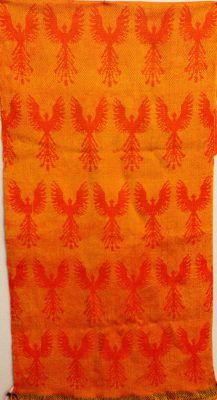
Here’s the front side for comparison:
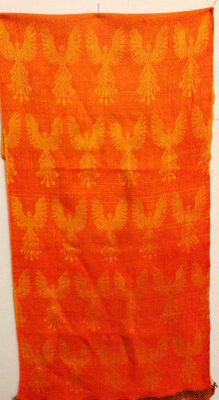
They felt the phoenixes were much more prominently visible on the “reverse” side. On reflection, I agree, though I’m still very fond of the front side.
Second, they really liked what I had been thinking of as the reverse side of the twill/doubleweave phoenixes (the black ones in the photo):
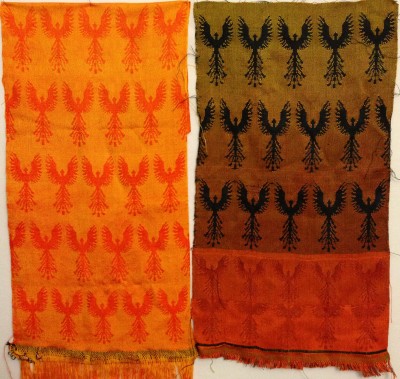
They felt it captured the idea of death really nicely, with the stark black phoenixes.
So how to combine the two for the idea of death/rebirth? My study group suggested a double-sided wall hanging, one side black phoenixes and one side scarlet ones. I sort of liked this idea, but thought it somewhat impractical – how would you hang it with both sides visible? It would have to hang in the middle of a room, and I just didn’t like the idea. Plus, you could only see one side at once
So I played with superimposing the images on each other in Photoshop. First I came up with this:
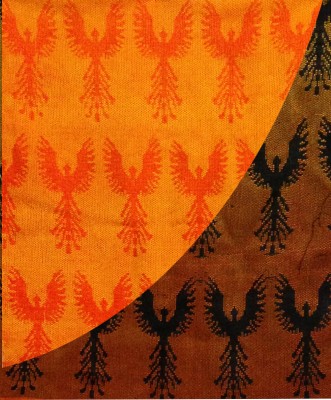
I was trying to capture the idea of the boundary between life and death, death and rebirth, but it wasn’t working for me. Why? Partly a visual thing: the scarlet phoenixes advance and the dark ones recede, so the piece felt unbalanced towards the scarlet phoenixes. (I tried reversing the image, but then it emphasized death rather than rebirth, which I also thought was wrong.) Partly a practical thing: there was no way I could get the phoenixes to line up perfectly, and the transition looked jarring with misaligned partial phoenixes.
No, I had to try something else. But what?
I spent another half-hour fiddling before the answer finally hit me in the face: Flame! Of course, make the scarlet phoenixes appear in a flame shape!
And finally I came up with this:
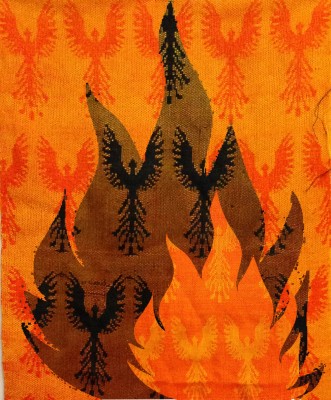
I really like this design, for a couple of reasons. First, it is much more visually interesting than the first one. Second, the layered flames convey the idea of death and rebirth – living phoenixes to dead ones to living ones again. Third, well, it’s just a better design, visually speaking.
And, you’ll notice, I managed to sneak in both sides of the scarlet phoenixes, giving the design more visual variety.
I am extremely happy with this design, so I think this is what I’ll do. However, I haven’t decided how to assemble it yet. There are basically two possibilities: fusing the design and appliqueing it. Upside of fusing the design is that it’s quick and stabilizes the edges: no worries about fraying. Upside of appliqueing is that the edges are neater and I can retain the suppleness of the fabric, which I think would be a problem with fusing. However, hand appliqueing would be very tricky because of the many sharp points and the tendency of handwoven fabrics to fray on handling. And I don’t like the look of machine applique. So I think I will probably fuse it, though I’ll have to test on samples first.
So there is quite a bit of work to be done. First, I need to weave more of the black-phoenix fabric, as the sample is quite small and full of flaws. Fortunately, I had only woven half the black warp! I have dyed more black weft and will weave off the remainder of the black warp using the twill/doubleweave design.
Second, I’d like to weave the scarlet/lemon yellow warp, and try overdyeing it. This may give me more options for the orange parts of the wall hanging, and some leeway should I botch a cot.
Third, I need to sample fusible webs to see how they impact the “hand” of the fabric. I may also experiment with machine applique, though I am not hopeful.
And, finally, there is the assembly and the photos. Deadline for this entry is April 8, which translates to April 1 for me, since I’m traveling April 2-9. So I have one month to do all that. I’m pretty certain I can do that, but there’s not much room for error.
Off to weave some black-phoenix fabric! The sooner started, the sooner done.

Since you’re thinking wall hanging, I’d go with the fusing so that the fabric is stable and hangs ‘flat’, too. 🙂
cheers,
Laura
I was scrolling through your article on the iPad, got to the final version and said “Yes!” before reading further. I have no experience with either fusing or appliqué but aggre that for a wall hanging, flat is best.
Great design! I’d suggest trying Misty Fuse. It’s very lightweight and unobtrusive.
What about surface design for the dark flames? You could cut a stencil for the circle of flames and lay it onto the fabric wherever you want it. I think that would look cleaner than applique/fusing.
The flames design is striking! I vote for fusing. There are so many fusing options out there today – you might even be able to find one that still retains enough suppleness to satisfy that desire.